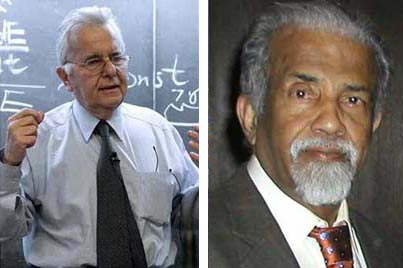
Nicola Cabibbo of the University of Rome “La Sapienza” and Ennackal Chandy George Sudarshan of the University of Texas at Austin have won the 2010 Dirac medal for their “fundamental contributions to the understanding of weak interactions and other aspects of theoretical physics”. Cabbibo and Sudarshan will each receive a $5000 prize from the Abdus Salam International Centre for Theoretical Physics (ICTP), which awards the medal every year on 8 August – Paul Dirac’s birthday.
Cabibbo is recognized for work that explored the significance of “quark-mixing” processes in interactions governed by the weak force. In particular, he established the existence of a new physical constant – now known as the Cabbibo angle – that determines the probability that a strange quark will mix with a non-strange quark, relative to the (much higher) probability of mixing processes where strangeness is conserved.
Cabbibo’s mixing matrix for strange-type and down-type quarks was later extended by the Japanese physicists Makoto Kobayashi and Toshihide Maskawa to include the third generation of quarks. The resulting “CKM” matrix led to a theoretical explanation of how charge–parity (CP) symmetry could be violated in weak interactions.
Sudarshan’s contributions to the physics of the weak interaction include his discovery of the “V-A theory” of weak interactions. Developed in collaboration with his PhD supervisor Robert Marshak at the University of Rochester in New York, US, Sudarshan’s theory was later incorporated into the full, unified theory of electroweak interactions that was developed by Sheldon Glashow, Abdus Salam and Steven Weinberg in the late 1960s. Sudarshan has also contributed to the theory of quantum optics, and was the first to postulate the existence of faster-than-light particles, known as “tachyons”.
Recognition ‘long overdue’
The Dirac medal is awarded to scientists who have not yet won a Nobel prize, Fields medal or Wolf Foundation prize. Both Cabbibo and Sudarshan were controversially passed over by the Nobel committee – the former in 2008, when Kobayashi and Maskawa shared the prize with fellow theorist Yoichiro Nambu, and the latter in 1979, when Glashow, Salam and Weinberg were honoured. Sudarshan also missed out on the Nobel in 2005, when Roy Glauber received a share of the prize for “contributions to the theory of optical coherence”, which include a technique that is sometimes known as the Glauber-Sudarshan P-representation.
In awarding the Dirac medal to Cabbibo and Sudarshan, ICTP director Fernando Quevedo called it “recognition that is long overdue,” and praised both physicists for their strong links to science in the developing world. ICTP was set up by Salam in 1964 to foster advanced studies and research in physics and mathematics, especially in developing countries.



